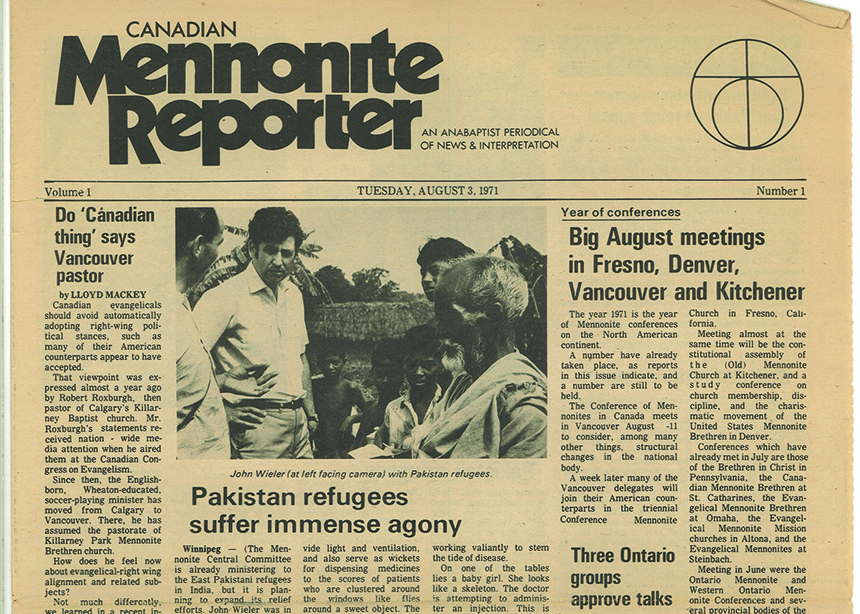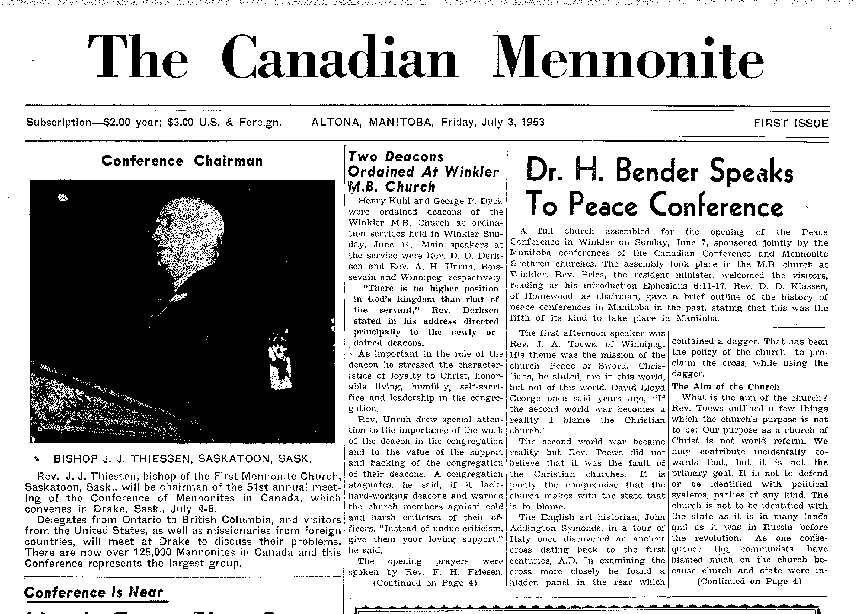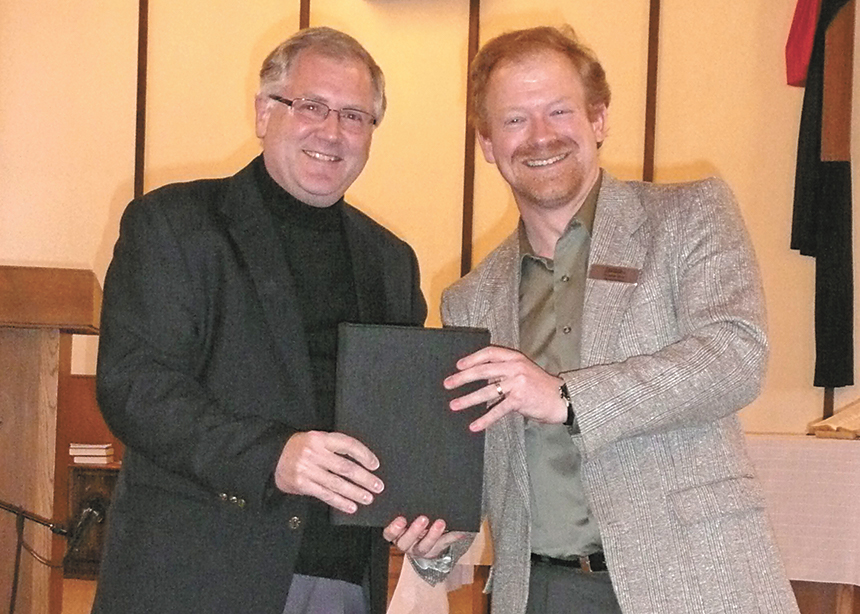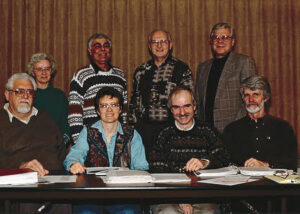This month marks the 65th anniversary of English-language magazine publishing for Mennonites in Canada.
The Canadian Mennonite, a precursor to the magazine you are holding in your hands (or reading on a screen), was launched in 1953 as “an English-language weekly, devoted to the affairs of Mennonites across Canada.” After publishing an introductory issue in July of that year to gauge interest, D.W. Friesen & Sons—the Altona, Man., publishing and printing company that had the vision for, and created, the publication—began producing the biweekly tabloid three months later, on Oct. 16, 1953.
An unsigned editorial in that issue, “High aims and high hopes,” noted that many readers had responded favourably to the July issue. At the same time, others questioned the wisdom of introducing another paper into the homes of Canadian Mennonites.
The editorial outlined that The Canadian Mennonite was to be a paper published in the interests of all Mennonite church groups in Canada. In its contents the paper was to present “articles of information,” such as news items from the various Mennonite districts and correspondence from readers, alongside “articles of instruction and inspiration,” like book reviews, stories, sermons and devotional material.
“In doing this, [the paper] will seek to present the pure teachings of the Bible as interpreted and proclaimed by the Mennonite church, reaching out to many Canadian Mennonite young people and others who do not, or cannot, read our German-language periodicals, and also presenting a united witness to our Canadian neighbours,” the editorial said.
“In a dominion-wide Mennonite community which is multiply divided, and in a Christian community which has often not felt the gospel testimony and the uncompromising peace position of a united Mennonite brotherhood, we believe that this new weekly has an important part to play,” the editorial continued. “To this end, we ask our readers to be prayerfully considerate and actively cooperative in this, a new venture.”
That issue featured Jesus’ words from John 8:31: “If you live what I teach, you are really my disciples,” on the front cover under the magazine’s name. The paper included news articles about a new church in Winkler, Man., a preview of an upcoming peace conference in Ontario and an item about David Schroeder, then the pastor of Bethel Mennonite Church in Winnipeg, contracting polio.
The paper featured short news items from the wider religious community in Canada, including a piece about movies, which “continued to gain popularity in Canada during the year of 1952.” A piece of fiction for youth, as well as a poem, filled subsequent pages, as did a short news item about a thief entering the campus of Canadian Mennonite Bible College and making off with approximately $200.
Letters from a handful of readers were published, congratulating the creators of The Canadian Mennonite.
“I can only express my appreciation that someone has finally seen it as his duty to publish one such paper,” wrote Nicholas W. Dick of Brandon, Man.
Launching The Canadian Mennonite was an immense task, Ted Friesen, one of D.W. Friesen’s three sons, recalled years later.
During a talk given at the Canadian Mennonite annual meeting in Altona, Man., in February 1999, Friesen said, “The church was changing. It was a period of flux, with the old trying to maintain the status quo and the new looking for change to meet the needs of the times. That was the situation facing the birth of this new paper.”
“To speak to the young people, to speak prophetically to the issues of the day, was urgent,” he added. “Most conferences were somewhat defensive, seeing the paper as a threat to their control. It is not surprising that many of the older generation were less than enthusiastic. But there were also many of that generation who saw the need and supported the paper.”
To guide The Canadian Mennonite, the Friesens hired Frank H. Epp, who was 24 years old at the time.
“Frank Epp’s contribution to Mennonites in Canada can hardly be measured,” Margaret Loewen Reimer wrote in Canadian Mennonite in 2003. “He became a courageous journalist, record-keeper of our history and a visionary leader.”
Epp’s editorials, Friesen noted, “challenged the Mennonite people of Canada to come to terms with being either separate, or being light and salt in Canadian society.”
In the beginning, a subscription to the paper cost $2. The publisher wrote that “such a periodical will not be a financially profitable enterprise, but we pray that it will be a worthwhile service to our Mennonite brethren everywhere.”
Friesens would have been happy if the paper had broken even financially, but that did not happen. Every year saw a substantial deficit.
In October 1962, subscribers totalled 3,500. That same month, Friesens transferred ownership of the paper to the Canadian Mennonite Publishing Company Ltd. The company was made up of 200 shareholders from eight Mennonite groups, who purchased shares at $100 each.
In June 1963, the publishing company changed to a non-profit corporation, the Canadian Mennonite Association.
Frank Epp left the paper in 1967, and was replaced by Larry Kehler as editor. In 1970, the board and staff looked carefully at the paper’s financial viability. That November, at the annual meeting, the members in attendance decided to close the paper in March 1971. The paper reported the news in an “obituary” published in the Nov. 13, 1970, issue.
“The Canadian Mennonite, 17, still mentally vigorous but suffering from a decided shortness of breath, has been given only four months to live. . . . The 60 members and friends of the association who gathered at The CM’s bedside last Saturday to take its pulse and to ponder its prognosis, decided that its ailment was terminal. . . . It is not an easy matter to judge when an institution has completed its mission, but . . . the trends in The CM’s operation were sufficiently clear.”
The trends cited included that “both religious and secular periodicals which cater to general audiences are losing readers, and also advertisers.” Readers “prefer something which is slanted specifically to their age group, vocation or hobby interests, etc.”
The last issue of The Canadian Mennonite was published on Feb.19, 1971.
“The closing of The Canadian Mennonite was painful for the staff and board, and for its readers,” Kehler recalled in 2003. “Many sent notes of thanks and condolence. We offered to refund unused portions of subscriptions, but few accepted this offer.”
A few months after The Canadian Mennonite’s demise, a new national paper, the Canadian Mennonite Reporter, was introduced to serve Canadian Mennonites.
Spearheading the effort was Aaron Klassen, chair of Mennonite Central Committee Ontario. Klassen found a group of 65 people ready to pledge funds to begin a new publication. An every-home plan supported by the Mennonite Conference of Ontario and the Western Ontario Mennonite Conference added about 3,000 subscribers.
Frank H. Epp was hired as editor of the new biweekly paper, David Kroeker was hired as managing editor, and the first issue of Canadian Mennonite Reporter was published in Waterloo, Ont., on Aug. 3, 1971. “Canadian” was dropped from the name the following year.
In 1973, Kroeker became the editor, with Loewen Reimer as assistant editor. Three years later, the Conference of Mennonites in Canada began promoting every-home circulation of the paper. Circulation was around 10,000.
In 1979, Ron Rempel took over the editor’s role at the Mennonite Reporter. Under his leadership, the paper transitioned from being an independent, inter-Mennonite periodical to becoming more closely linked to the Conference of Mennonites in Canada (now Mennonite Church Canada). This process eventually led to the beginning of a new magazine and a new circulation plan.
The first issue of Canadian Mennonite was published on Sept. 15, 1997. It was in a magazine format with colour added. The Conference of Mennonites in Canada and its area conferences agreed to buy subscriptions for all members. This added 9,000 new subscribers.
In 2003, Rempel ended his role as editor/publisher. Loewen Reimer served as interim editor/publisher for 2003-04. Timothy Miller Dyck became editor/publisher in August 2004, a role he held until March 2009.
Loewen Reimer retired from Canadian Mennonite in January 2005, and was succeeded by Ross W. Muir as managing editor.
Miller Dyck was succeeded in March 2009 by Dick Benner, a journalist from the United States, who served as editor/publisher until March 2017. When Benner retired, the role of editor/publisher was replaced with two positions: executive editor and publisher Virginia A. Hostetler, who previously served as the magazine’s web editor, and Tobi Thiessen, were hired to fill the roles, respectively.
Today, Canadian Mennonite continues to serve readers with a biweekly magazine whose mission is “to educate, inspire, inform and foster dialogue on issues facing Mennonites in Canada as it shares the good news of Jesus Christ from an Anabaptist perspective. We do this through an independent publication and other media, working with church partners.”
The magazine names Hebrews 10:23-25 under its guiding values: “Let us hold fast to the confession of our hope without wavering, for he who has promised is faithful. And let us consider how to provoke one another to love and good deeds, not neglecting to meet together, as is the habit of some, but encouraging one another, and all the more as you see the day approaching.”
Quotes of affirmation over the years
“I feel much more connected to the larger church and what people are thinking. Even if I don’t agree with what the people think, it is very good for me to understand their points of views.”
“Latest issue of @CanMenno landed in my inbox today, with exceptionally good coverage on a number of fronts, including the jailing of @mennochurch staffer @heinrichs_steve in B.C. and Toronto’s Danforth shooting. First-rate church journalism.”
“Glad to be getting both electronic and hard copy here in South Africa. It’s a good way to keep up with MC Canada and the whole Mennonite world. Glad also to be able to share particular articles with folks here.”
“Your paper enters our home faithfully every week like an old friend and talks with us. It brings people like Ron Sider, Phil Wagler, Brother De Boers, and others who encourage us to greater faithfulness. . . . It connects the body of Christ across this nation.”




















Leave a Reply
You must be logged in to post a comment.